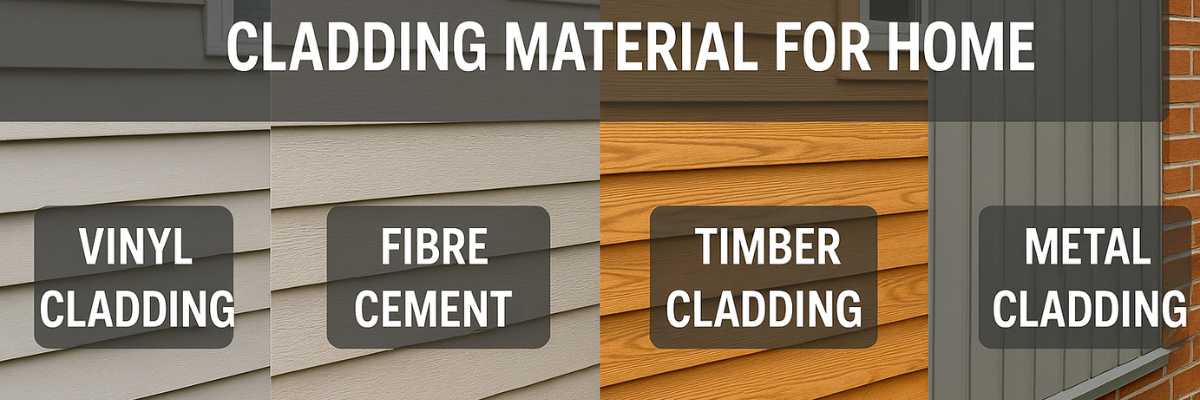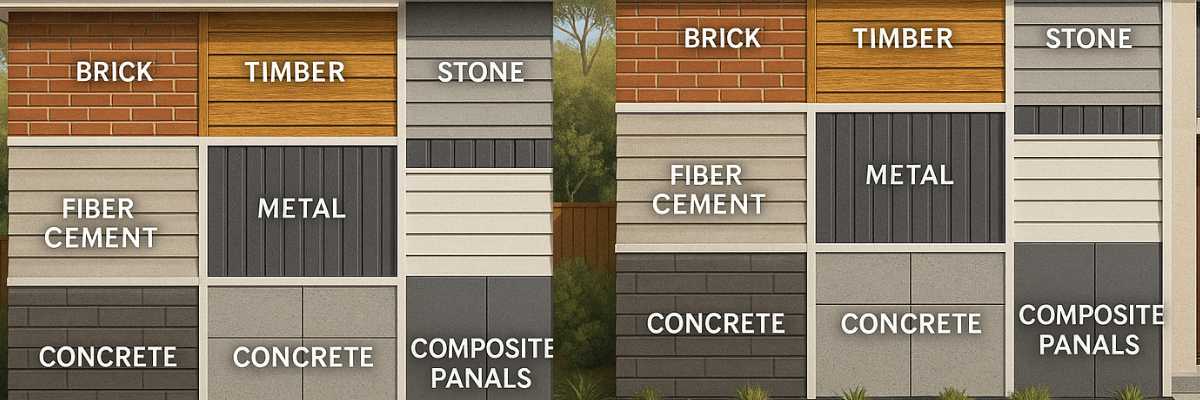One of the most significant issues that homeowners have to face when designing or remodelling a house is selecting cladding material. Cladding covers the outer appearance of your home as well as provides insulation, protection against the climate, and the longevity of the home. Since there are plenty of choices, one may have difficulty in determining which material provides the best quality and reasonable price. Let us discuss the most common and affordable options for cladding to assist those planning to improve and protect their interior and exterior walls.
Understanding cladding
Cladding refers to wall covering that forms a shield from different natural forces that may include rain, wind and ultraviolet radiation. It not only protects the base, as a construction, from weather effects that may harm it but also applies a form of insulation thereby enhancing energy requirements. Apart from the pragmatic aspect, cladding is a vital part of the determining aesthetics and general appearance of the structure providing extremely versatile choices in terms of stylistic possibilities, textures, and colours to create specific visual looks.
Interior cladding refers to the application of decorative or protective materials on walls and ceilings inside a building. It enhances aesthetics, insulation, and moisture resistance while covering imperfections. Common materials include wood, PVC, stone, and metal, offering various styles to complement modern or traditional interiors.
Exterior cladding involves covering a building's outer structure with protective and decorative materials. It improves insulation, weather resistance, and durability while boosting curb appeal. Popular materials include brick, stone, wood, vinyl, and metal, each offering unique benefits in terms of appearance, maintenance, and climate suitability.
Together with the main types of cladding – timber and metal, familiarising with available options and their characteristics assists in making a correct choice based on the functioning criteria and aesthetic expectations.
How much can you expect to pay for cladding in Australia?
When selecting cladding for your home in Australia, it is important to have an understanding of the various expenses concerning the material.
- Vinyl cladding is one of the cheapest costing an average of $2 – $7 per square foot, this makes it quite popular, especially for individuals who are working on a limited budget.
- Fibre cement cladding retails at $5 to $10 per square budget since it is an efficient and flexible material.
- Brick cladding which is a durable classic option can cost about $6-$15 per square foot depending on the type of bricks used and the design implemented.
- Timber cladding also differs in terms of price and cost which lies between $5-$15 for every square foot depending on the type of timber and whether it is treated or not.
- If the house owner wants a modern outlook of the house then metal cladding is available in aluminium or steel and it costs $7 to $20 per square foot. This material is hard-wearing and easy to maintain but can be costly because of this factor installation.
- Another kind costs $7 to $15 per square foot – composite cladding that comprises wooden fibres and plastic, and looks like wood but doesn’t need the same level of care.
- Stucco is an exterior cladding well known for its insulation and abrasive face finish; it costs between $6 and $12 per square foot but requires professionals in its installation since poor workmanship results in a host of policy problems in the ensuing years.
- Integrated stone cladding comes in natural or cultured and costs a bit higher ranging from $10 to $30 per square foot and is considered to be more durable and iconic.
- The glass cladding is the most costly option that may cost from $20-$50 per square foot depending on the type and the extra amenities.
What are the various life expectancies of the different cladding options available?
Cladding material has a different durability when used in construction work; hence it has a different life expectancy.
- Vinyl cladding is rather durable and like most cladding materials does not allow moisture penetration and wear due to direct exposure to UV rays and has a life expectancy of between 20 to 40 years.
- Fiber cement is the cladding that has a longevity of 25 to 50 years because of its feature of resistance to fire and pests.
- Timber cladding is shorter than metal with an estimated durability of 15 – 30 years depending on factors such as; weather conditions and the level of maintenance.
- Stone cladding has been reported to have a very long life span, which may exceed 50 years, metal and glass cladding have been rated to last between 30 to 50 years under proper conditions.
All materials have their own life spans depending upon their adaptability towards environmental conditions and their maintenance.
Weatherboards: One of the most affordable cladding options
Timber weatherboards are most affordable to most homeowners especially when they are pre-painted or fiber cement ones. For instance, the cost of a weatherboard per square footage price is between $5 to $10 and therefore makes it cheaper than high-end trimmings such as stone or glass. Its low price is made better by how easy it is to install, especially with today’s materials that do not need a lot of work. But usual timber weatherboards will cost more in terms of maintenance over the years as the building will require to be painted and treated for rot and bugs. All in all, as much as using weatherboard cladding is inexpensive in the first place, the eventuality of this house being cost-effective largely depends on the type of material to choose and the level of commitment to maintaining it.
Maintenance costs for cladding in Australia
Vinyl cladding is an easy-to-maintain material that does not require any major work other than hosing down with soapy water to clean. As a result, its vulnerability to moisture and pests is relatively low, hence rarely succumbing to problems such as rot or insect damage and hence it requires low maintenance. However, such a design material as vinyl may eventually fade or experience slight damage and this may call for the replacement of the panels or touching up the area.
Fiber cement cladding for instance is more durable than other forms of cladding and it also requires minimum maintenance. That way, one doesn’t need to paint very often, but it is necessary to check the exterior surface for any cracks or other damage that could allow water to penetrate the structure, causing more severe problems. Fibre cement is rather invulnerable to pests and rot and is most likely to be painted every 10 to 15 years.
Still, timber cladding has a relatively higher cost of maintenance mainly because of the effects of weathering and pests. Timber in structures requires periodic treatment or repainting to avert rotting, infestation by insects and UV ray degradation. Hence, it is recommended that staining and other treatments may need to be done in intervals of 2 to 5 years depending on the type of timber and climate respectively.
Is plaster cladding a cost-effective option?
Plaster cladding is cheap for many homeowners because the material costs a little and installation costs are moderate. Used as a finish coat with a more economical base such as concrete or masonry, plaster offers a sleek surface with a variety of options in terms of patterns and designs without having to go with expensive stones or other superior composite materials. A surface idea can be used in different textures and colours, hence the added additional finishes are not necessary. Nonetheless, although plaster cladding is inexpensive, the houses may need more frequent repairs and maintenance than when constructed from other materials that are more long-lasting and this may add some cost to the whole project's comprehensiveness.
Are bricks possibly one of the cheapest cladding materials?
Brick cladding also falls in the category of inexpensive external cladding material since it is one of the most durable and easy to maintain. The cost of brick, for instance, may be between $6 to $15 per square foot, which can be pretty expensive compared to other materials, it is as mentioned above very durable and requires little or no maintenance, therefore can be cost-effective in the long run. Brick is also immune to forces of weathering, fire and pests hence it does not require constant repair or replacement. Hence, perhaps the most important aspect of a well-sited dense building is its thermal mass, which might contribute to the reduction of the utility bills for heating and cooling. Hence it is clear that even if the initial cost of using brick cladding is high, the long-term benefits are such that brick cladding proves to be a cheaper option in the long run.
More factors affecting the cost-effectiveness of cladding
Fundamentally, four parameters that define cladding costs as a subsystem erection type are: material type, erection difficulty, and maintenance requirements. Some of them such as stones or glass are relatively expensive to obtain in the first place but they may last longer and will not require frequent replacements. However, siding materials such as Vinyl or fibre cement will cost significantly lower initial price but may need repairs or replacement every few years hence the cost implications.
Also, the complexity of the installation process is an important factor in determining the cost in question. This is true since additional accessories and extra items that need additional support during their installation can lead to a rise in labour costs. The frequency of maintenance requirements also has an impact in terms of affordability; for instance, timber requires frequent maintenance or treatment and thus would be more expensive in the long run than other materials like brick, and metal among others. Considering these factors assists in arriving at a good decision on the selected cladding material that would have a fair cost implication for the initial investment as well as the future returns.
Conclusion
When selecting the type of cladding and material for your house, it’s important to consider both the short-term and long-term cost implications, including replacement and maintenance expenses. Vinyl cladding and fiber cement, for example, allow homeowners to cover large areas at a relatively low cost and require minimal maintenance. On the other hand, materials like stone cladding or composite may have a higher upfront cost, but their durability and aesthetic appeal can make them more cost-effective in the long run. Wall cladding options vary widely based on factors like climate conditions, architectural styles, and maintenance requirements, so your choice should also reflect how much time and money you're willing to invest in upkeep. By factoring in the cost of cladding, the expertise of cladding installers, and the potential returns, you can make a well-informed decision about the best cladding material for your home.













